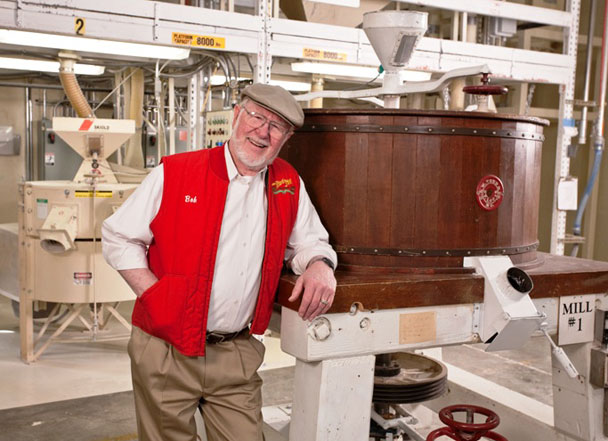“I don’t think there are any grains we don’t have that we should have,” says Bob Moore. Given that Bob’s Red Mill, the Portland, Oregon, company that bears Moore’s name, produces and sells more than 400 types of flours, meals, mixes, seeds, oats, cereals, and, of course, whole grains, this seems an eminently reasonable claim.
But while Bob’s Red Mill products—many stone-ground, often organic, and invariably sporting Moore’s bespectacled, white-bearded image—are a staple of many a natural food enthusiast’s pantry, the 34-year-old company is arguably most beloved by the gluten-free community. Bob’s markets more than 50 gluten-free products, from active dry yeast and black bean flour to xanthan gum and teff flour. Gluten-free items currently represent about 30 percent of revenue, and according to Moore account for the company’s biggest growth area.
The current explosion of interest in gluten-free cooking and baking may have helped Moore’s business, but Bob’s Red Mill has actually been around for decades. The seeds of Moore’s success were planted back in the 1960s, when his wife Charlee’s “concern for our health and what we ate” first sparked an interest in whole grains, Moore, now a vigorous 83, recounts. At the time, whole grains were being championed by prominent nutritionists like Gayelord Hauser and Adelle Davis, as well as the recently launched Prevention magazine. It was also an era when scientists were beginning to understand the genetic nature of celiac disease, or gluten intolerance.
Moore was in an entirely different line of work at the time—managing a Firestone auto center—and living with his wife and their three young sons on a rented dairy farm outside Sacramento. For Moore, the true turning point came when he picked up a copy of John Goffe’s Mill, George Woodbury’s real-life account of the restoration of an old gristmill in New Hampshire. Inspired both by Woodbury’s success and the appealing notion of an old stone mill slowly grinding flour, Moore began researching milling gear at the local library.
A few form letters and phone calls led him to Fayetteville, North Carolina, where he salvaged equipment from a defunct mill. In 1972, he and Charlee opened their first mill in a rented factory in Redding, California. They started by milling cornmeal, corn flour, whole wheat flour, and whole wheat pastry flour. For six years, “the mill was kind of done on the side on weekends and evenings,” Moore recalls, while he maintained his job at the auto center. Although the new venture was successful, the Moores realized early on that the small-scale, local nature of the business could not sustain them and their children’s growing families. And so in 1978, Moore and his wife sold their share of the mill. They left it in the hands of two of their grown sons, who still own and operate it to this day, supplying Bob’s Red Mill with its corn grits and granolas.
Meanwhile, Moore and Charlee moved to Moore’s hometown of Portland, where he attended seminary classes to fulfill his longtime dream of studying the Bible in the original Hebrew and Greek. Not long after the move, Moore and Charlee took a stroll one day and happened upon their destiny in the form of an abandoned mill. Over the next decade, they turned that mill—whose red paint inspired the company’s name—into a thriving small business, supplying natural food stores throughout the Northwest. In 1991, after attending a major natural products trade show in Anaheim, California, the company began distributing its products on a national level.
Moore’s first opportunity in the gluten-free niche came in 1985, when members of the Seattle-based Gluten Intolerance Group approached Moore and encouraged him to sell xanthan gum, an agent that gives gluten-free baked goods viscosity and bulk. Moore tracked down the San Diego manufacturer of this key ingredient and began using xanthan gum in his mixes, as well as repackaging it for sale under the Bob’s Red Mill name. The Seattle advocacy and support group also pressed him to separate naturally gluten-free grains, such as rice, from his other products. “I didn’t think rice could be mixed with whole wheat flour and you’d have a contaminated product,” he recalls. “To me, they were all whole grains and good for you.” Moore says he realized that if his company was going to make gluten-free products, it was important to use separate mills. Today, Bob’s has an entirely separate facility for manufacturing and packaging gluten-free goods, as well as a laboratory for developing new gluten-free products. “Because we’ve gone into it so thoroughly,” Moore states, “I just feel we’ve done the right thing with gluten-free.”
When you look at national trends over the last few years, Moore’s dedication to the gluten-free niche seems prescient and well placed. Across the industry, “sales of gluten-free products exceeded $6 billion in 2011, and grew 27 percent since 2009,” says food trend forecaster Suzy Badaracco, citing statistics from the market research firm Mintel. Although Badaracco, founder of the forecasting firm Culinary Tides, predicts that the gluten-free phenomenon is a bubble that will burst sooner rather than later, companies whose products already have a loyal following and have been forward-thinking rather than opportunistic are far less likely to, as Badaracco puts it, “get caught with their pants down.”



 Pinterest
Pinterest


